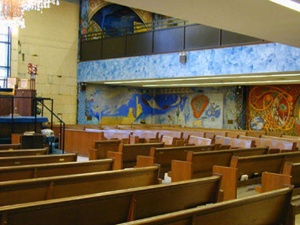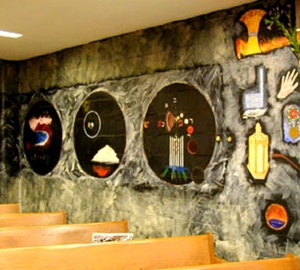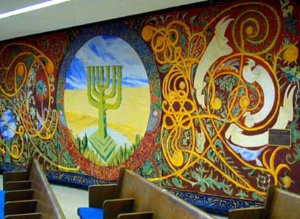The Painted Shul
At the corner of Ocean Parkway and Avenue P in Brooklyn stands Congregation B’nai Yosef, a distinguished Sephardi synagogue affectionately known as the “Painted Shul.” From the street it is an unremarkable structure; a freestanding early nineteen-seventies building sporting a three-story brick façade. But once you ascend to the main sanctuary one flight up you have entered a transformed space.

Every square inch of wall space in the large prayer hall is shimmering with brightly colored murals. The women’s balcony upstairs and the men’s section downstairs are dominated by a never ending parade of symbols, images, abstract patterns and decorative shapes that reverberate against one another, a mad kaleidoscope of Jewish cosmology, folklore and thought. A lion and a stag stare out from the back wall while dark brooding abstractions contrast with mysterious kabalistic symbols floating around the periphery. Tall smoked glass windows punctuate the walls and an elaborate crystal chandelier hangs over the raised wooden Reader’s Desk. A three-dimensional trompe l’oeil depiction of the Western Wall in Jerusalem frames the enormous Torah ark.
The creator of this cacophony is Archie Rand, a well-known Jewish painter and professor of visual arts at Columbia University. Recently he was named as Fellow of the Guggenheim Foundation and a Laureate of the National Foundation for Jewish Culture. These latest achievements crown a thirty-year career in Jewish art that began in this very sanctuary.

The genesis of these paintings is as singular as the works themselves. Back in 1973 Rand was primarily an abstract color field painter, showing at the prestigious Tibor de Nagy Gallery on 57th Street. But that couldn’t pay the high tuition bills for his daughter’s schooling so he created three enormous murals as payment for one year’s yeshiva education. The school loved the new paintings. Flush from this success he was approached about a project to paint murals for the interior of B’nai Yosef. This new synagogue, in the heart of the Sephardi community of Brooklyn, had been built and founded by one charismatic and mysterious individual who has maintained total anonymity. The synagogue has no membership dues or sales of seats and prides itself as simply devoted to prayer and religious study.
Rand was at first apprehensive about doing anything that might be defined as “synagogue art.” The cultural milieu of the seventies defined representational and religious art as definitely beyond the pale. Postmodernist minimalism and conceptualism reigned supreme in the Manhattan gallery scene. Nevertheless, encouraged by a new potential patron, he ventured to create a trial project. What emerged was a rather traditional depiction of the Western Wall executed in his usual eclectic manner, using Brighton Beach sand in the paint and tufts of faux foliage dotting the wall. Pleased with the results, the synagogue’s sponsor awarded him the job to paint murals for the remaining walls and he accepted. While Rand has never met the man who commissioned the paintings, he has enjoyed his unflinching support, though always through intermediaries. Unfortunately that was not the case with Rand’s art world friends back in Manhattan. Once word got out that he was working on a big mural commission in an Orthodox synagogue in Brooklyn he was treated as a traitor by most of his art world associates. He had dared to cross the forbidden line of religion and representation.
As Rand turned his full attention to the massive mural project encompassing over eight thousand square feet of cinderblock wall he had to first find an appropriate inspiration. It seemed that he would have to somehow invent a new Jewish iconography to express his ideas. To fill an Orthodox synagogue with images was no ordinary task and, frankly, he didn’t have a clue as to where to begin. He discovered the scholarly work Erwin Goodenough had done on the famous Dura-Europos murals. Uncovered in Syria in the 1930’s, these frescos were fully figurative depictions of Biblical stories adorning the walls of a third century synagogue. Their discovery and publication had revolutionized scholarly opinion about Jewish use of figurative decoration in the ancient world. Scholars were now saying that the Jewish ban on graven images was not historically absolute. He felt that this precedent gave him the intellectual license to do figurative work in a modern synagogue. Still he needed specific and legitimate subjects to work with in this particular community.
Congregation B’nai Yosef is comprised of very conservative, insular Sephardi Jews, mostly from North Africa and Syria. This community is frugal, non-ostentatious and most importantly, very strict in their religious observance. Almost every male has a yeshiva education and there are many ordained rabbis in the congregation. As a young artist with only a basic Hebrew School education Rand had to engage in intensive study just to approach the level of his Jewishly educated audience. He arranged to study ‘one on one’ with yeshiva students, first locally and then at the prestigious Mesivta G’vohah in Lakewood, New Jersey in order to more sharply define his subject matter. His studies concentrated on the basic commentaries surrounding the narratives of the Bible. With time his studies focused on more esoteric and kabalistic insights unique to the B’nai Yosef community. According to Rand, after awhile these subjects became “the nouns” of his creative material. Now armed with very specific concepts about biblical stories or textual passages, he was ready to start to shape his ideas into images.

He started work on his mural at the rear of sanctuary by depicting Benno Elkan’s monumental bronze menorah that stands outside the Knesset in Jerusalem. Rand surrounded this symbol of the Jewish state with an exuberant design reminiscent of medieval manuscript “carpet page” illuminations. These famous illuminations used geometrical and organic designs interspersed with symmetrical patterns to decorate the manuscript pages of pure text. Rand’s image combined a fantastic Syrian carpet decoration with the powerful Zionist symbol for sure-fire approval. His sponsor was pleased and the work continued with his full backing and the tacit approval of Rabbi Benoliel, an influential Turkish rabbi in the congregation. As the images began to appear on the walls some of the congregation approved of the paintings while others reacted to the strange new creations with hostility. Of considerable contention was the area to the left of the aron that depicted the first days of Creation in a dark corner of multiple black circles replete with numerous mystical symbols. The mural continued around the corner and explicated in realistic shorthand the ten things created immediately before the first Sabbath: among them a donkey’s head, a Noah’s rainbow, a Miriam’s well and the square tablets (as yet blank) of the Decalogue themselves. To say the least, the predominance of black on a field of steely gray with seemingly random symbols floating over the surface was a new and unfamiliar aesthetic experience for most of the congregation.
As he continued to work, Rand was suddenly confronted by a group of furious community rabbis. They accused him of the biblical sin of idolatry for his creation of images. The rabbis took issue with specific images they deemed as inappropriate or those that they interpreted as Christian symbols, especially shapes that formed what appeared to be crosses. They felt the paintings were a serious distraction and were culturally insensitive to their community, particularly the negative implications of so much black color. Rand was equally furious and defended himself asserting that he had made every effort to be sensitive to the subject matter and the community. In the heat of the controversy, he took six months off to remove himself from the fray. Rabbi Lopian, a local supporter, took the dispute to the foremost rabbinic authority of the day, Rabbi Moshe Feinstein. Armed with photographs of the first four panels of the mural, the hostile rabbis asked the world renowned sage if “Jewish Art” was indeed permissible in their synagogue, and if so, was this current work appropriate. “The work is kosher and the spirit under which the work was done is commendable,” was Rabbi Feinstein’s unambiguous answer. While Rabbi Feinstein never formally recorded his decision, Rand believes that a passage in a collection of his comments on the weekly Torah portion reflects his final opinion. “…we must be aware that anyone who has special talents, such as Bezalel’s artistry, has to realize that Hashem (God) gave him these talents only to use them to do His will, either on behalf of the Jewish people or directly to increase His honor in the world…If he fails to do what is expected of him, Heaven forbid, eventually he will be called to account for misusing his talents.” (Darash Moshe on the Torah, Mesorah Publications, 1994, pg. 155) Rand, bruised but vindicated, was pleased. He proceeded with the massive project over the next three years, slowly developing a new aesthetic in response to these persistent rabbinic and community tastes.
Published in The Jewish Press